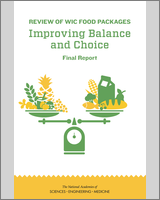
NCBI Bookshelf. A service of the National Library of Medicine, National Institutes of Health.
| WIC Food Category | DGA Food Group | Units/d | WIC Maximum Allowance | DGA 1,300-kcal Food Pattern | % of 1,300-kcal DGA Recommendationb |
|---|---|---|---|---|---|
| Total fruit | Total fruit | c-eq | 0.9 | 1.25 | 69 |
| Juice, 100% | Fruit, juice | c-eq | 0.5 | 0.5h | 107 |
| Fruit, 67% of CVVc | Fruit, whole | c-eq | 0.3 | 0.7 | 43 |
| Total vegetables | Total vegetables | c-eq | 0.3 | 1.5 | 19 |
| Vegetable, 33% of CVVd | c-eq | 0.2 | 1.5 | 11 | |
| Legumes (as a vegetable)e,f | Beans and peas | c-eq | 0.13 | 0.07 | 177 |
| Total dairy | Total dairy | c-eq | 2.1 | 2.5 | 85 |
| Milk | c-eq | 2.1 | 2.5 | 85 | |
| Total grains | Total grains | oz-eq | 2.3 | 4.5 | 50 |
| Breakfast cerealg | Refined grains | oz-eq | 1.0 | 2.3 | 43 |
| Breakfast cereal | Whole grains | oz-eq | 0.2 | 2.3 | 58i |
| Whole wheat bread | Whole grains | oz-eq | 1.1 | ||
| Total protein foods | Total protein foods | oz-eq | 1.0 | 3.5 | 29 |
| Peanut butterf | Nuts, seeds, and soy | oz-eq | 0.6 | 0.4 | 167 |
| Eggs | Meat, poultry, and eggs | oz-eq | 0.4 | 2.4 | 17 |
| Fish | Seafood | oz-eq | 0.0 | 0.6 | 0 |
NOTES: c-eq = cup-equivalents; CVV = cash value voucher; DGA = Dietary Guidelines for Americans; NR = no recommendation; oz-eq = ounce-equivalents.
Some values in this table are corrected from the original prepublication version.
The DGA apply to individuals ages 2 years and older; therefore, although food package IV is issued to younger children, the table is applicable only to those ages 2 to less than 5 years.
For children ages 2 to less than 5 years, the median calculated Estimated Energy Requirement was 1,517 kcals. A food pattern of 1,300 kcal was selected for this age group because (1) 1,500 kcal/d may reflect recent increases in body weights for young children and was considered too high for normal weight children in this age group, particularly in light of efforts to reduce and/or contain the prevalence of childhood obesity, and (2) the 1,300-kcal pattern was applied in both the previous WIC food package review (IOM, 2006) and the Child and Adult Care Food Program (CACFP) report (IOM, 2011a) and should similarly be appropriate for current WIC participating children of the same ages. Percentages represent the proportion of the recommended food pattern amount in the corresponding row of the DGA food pattern column.
Assumes that 67 percent of the CVV is used to purchase fruits, based on redemption data from Texas and Wyoming. A weighted composite cost of fruit ($0.55/c-eq) was developed, based on a composite of the most commonly consumed fruits (bananas, apples, oranges, berries, grapes, melon [watermelon was used in this case]) from an average of Massachusetts, Texas, and Wyoming redemption data. Only fresh fruit was included as all states allow fresh forms; ERS 2013 price data were updated with a consumer price index to 2015 values.
Assumes that 33 percent of the CVV is used to purchase vegetables, based on redemption data from Texas and Wyoming. A weighted composite cost of vegetables ($0.55/c-eq) was developed, based on a composite of the most commonly consumed vegetables (tomatoes, avocados, potatoes, peppers, lettuce) from an average of Texas, Wyoming, and Massachusetts redemption data. Only fresh vegetables were included as all states allow fresh forms; ERS 2013 price data were updated with a consumer price index to 2015 values. Because potatoes were not yet available in Wyoming, the same proportion of potatoes was assumed for this state as for Texas.
Legumes can also be assessed as a protein, but were placed in the vegetable group because a higher proportion of individuals had low intakes of vegetables across WIC participating subgroups compared to protein.
Assumes 50 percent legumes and 50 percent peanut butter. Because these values account for the proportion of the maximum allowance of legumes and peanut butter provided per month, they are lower than those presented in the phase I report (NASEM, 2016).
In the current food packages, a ratio of 81 percent refined grains and 19 percent whole grains was applied, based on redemption data.
Equivalent to 4 oz per day, the lower end of AAP guideline of not more than 4–6 ounces per day.
To compare the food package contribution to the DGA recommended amounts of whole grains, the whole grain portion of breakfast cereal was added to the whole grain contribution of bread.
SOURCES: USDA/ARS, 2014; USDA/FNS, 2014; USDA/HHS, 2016. State-specific data are available in the public access file for this study (Email: paro@nas

NCBI Bookshelf. A service of the National Library of Medicine, National Institutes of Health.